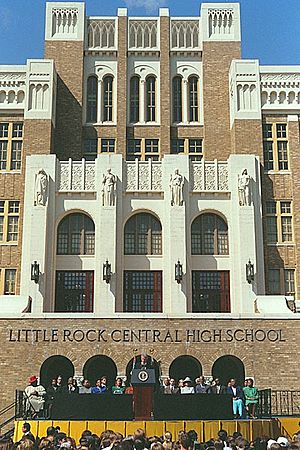National Register of Historic Places listings in Little Rock, Arkansas facts for kids
Little Rock, Arkansas, is home to many important buildings and places that tell stories about its past. These special spots are listed on the National Register of Historic Places. It's like a special club for buildings, neighborhoods, and other places that are super important to the history of the United States. When a place is on this list, it means it's worth protecting and remembering for future generations.
In Pulaski County, Arkansas, where Little Rock is, there are 351 places on this list. Little Rock itself has 265 of these historic sites. Some of them are even more special and are called National Historic Landmarks. These are places that have played a huge role in the history of the entire country!
Contents
What is the National Register of Historic Places?
The National Register of Historic Places is the official list of places in the United States that are important for their history, architecture, archaeology, engineering, or culture. It's managed by the National Park Service. Listing a place on the Register helps people understand its value and encourages its preservation.
Famous Historic Places in Little Rock
Little Rock has several places that are not just locally famous but are known across the country for their historical importance.
Little Rock Central High School
Little Rock Central High School is one of the most famous historic places in Little Rock. It became a National Historic Landmark because of its role in the Civil Rights Movement. In 1957, nine African American students, known as the "Little Rock Nine," tried to attend this all-white school. This event was a major step in ending segregation in schools across America. The school is now a National Historic Site, meaning it's protected and visited by people from all over the world.
Old State House
The Old State House (Little Rock) is another National Historic Landmark. It was the first state capitol building in Arkansas. This beautiful building, finished in 1842, saw many important decisions made for the state. It's a great example of old architecture and now serves as a museum where you can learn about Arkansas's history.
Daisy Bates House
The Daisy Bates House is also a National Historic Landmark. Daisy Bates was a brave civil rights activist who helped guide the Little Rock Nine. Her home was a meeting place for the students and a center for the Civil Rights Movement in Arkansas. It's a powerful reminder of the fight for equality.
Joseph Taylor Robinson House
This house was the home of Joseph Taylor Robinson, a very important politician from Arkansas. He served as the state's governor and later as a U.S. Senator. He had a big impact on national politics during the 1930s. His house is recognized for its connection to his important work.
Other Interesting Historic Sites
Many other buildings and areas in Little Rock are also listed on the National Register. These places show different parts of the city's history, from old homes to churches and commercial buildings.
- Arkansas State Capitol: This is the current building where Arkansas's government works. It's a grand building that has been important to the state for many years.
- Capital Hotel: A historic hotel in downtown Little Rock, known for its beautiful design and long history of hosting important guests.
- Mount Holly Cemetery: This old cemetery is the final resting place for many famous Arkansans, including governors, senators, and other important figures. It's like an outdoor history book.
- MacArthur Park Historic District: This area includes a large park and several historic buildings, like the Tower Building of the Little Rock Arsenal, which is where General Douglas MacArthur was born.
- Hillcrest Historic District: A neighborhood known for its beautiful old homes and tree-lined streets, showing how people lived in Little Rock many years ago.
Why are these places important?
These historic places help us understand where we came from and how our city and country grew. They teach us about the people who lived here before us, the challenges they faced, and the amazing things they built. Protecting these sites means we can keep learning from them and share their stories with future generations.






